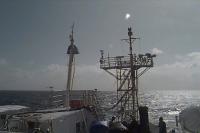Aerosols99 and INDOEX
The Aerosols99 and INDOEX research cruise occurred on the NOAA ship Ronald H. Brown between January 14 and March 30.
The Aerosols99 cruise crossed the Atlantic Ocean from Norfolk, Virginia to Cape Town, South Africa between January 14 and February 8, 1999. The goals of the cruise were to determine the chemical, physical, and optical properties of the marine boundary layer (MBL) aerosol, the vertical distribution of aerosols and ozone, the column integrated aerosol optical depth and the ozone, CO and peroxy radical chemistry in the MBL. Sampling strategies were optimized to obtain data sets to evaluate satellite derived ocean color (SeaWiFS), aerosol optical depth (AVHRR) and total column ozone (TOMS). The cruise track crossed through 7 different meteorological/oceanographic regimes ranging from background marine air masses in the Northern and Southern hemispheres to air masses containing mineral dust and the products of biomass burning
The INDOEX research cruise left Capt Town on Febuary 11 and ended in Male, Maldives in March 30. The cruise was an important component of the Indian Ocean Experiment (INDOEX). This project was a large multi-national, multi-agency intensive field experiment in the Indian Ocean with three interrelated objectives:
- Assess the significance of sulfates and other continental aerosols for global radiative forcing.
- Assess the magnitude of the solar absorption at the surface and in the troposphere including the intertropical convergence zone (ITCZ) cloud systems.
- Assess the role of the ITCZ in the transport of trace species and pollutants and their resultant radiative forcing.
Link to main INDOEX webpage at UCSD



